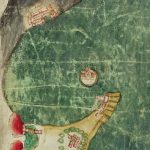Galeas per montes
Galeas per montes
It runs the year 1438, the militias of Filippo Maria Visconti are besieging Brescia and the Serenissima has all the streets blocked to be able to help, the decision is taken by the Venetian Senate to implement an idea that has incredible, to get the ships on the Benaco going up the Adige and then transporting them on land passing from the lake of Loppio to get around the enemy lines, conquer the castle of Salò and then bring reinforcements to Brescia. This is how Marco Gerosa tells his story in his “The Benaco in memories and in the sovereign beauties”.
Galeas per montes. A fleet passes Baldo. The Venetian army was powerless to support the heroic city. On 1 December 1438 the doge wrote to Pasquale Maripiero inviting him to help Brescia, both through the mountains and the lake. For its part, the Senate decided to stick to the project implemented by Biagio degli Alberi and Nicolò Sorbolo. These to overcome the difficulties of the lack of arsenals on the Benaco, suggested to allocate to the lake a certain number of canals making them go up again for the Val d’Adige. The ardent design encountered serious obstacles, besides the impervious roads also for the difficulties of security on the Adige and on the Mincio, which were for the most part in power of the enemy, much more than the marquis Gonzaga of Mantua had formed an alliance with the Duke of Milan watching those rivers. The Sorbolo, a native of Candia, a very expert man of the sea, must first, as is the case of all the arduous, unlikely enterprises, arouse mockery and contempt. Other simpler means were examined to help Brescia, but in the end the proposal by the old sea dog was insistent to impose itself on the Signoria, who decided to study it, to examine it and concluded with the approval of it as the only solution in the extreme case and desperate.
The arsenal of Verona was commissioned to build two large galleys, three other minor and thirty – five small vessels between galeotte and gazzare which were soon to be sold with considerable expense, and under the direction of the Sorbolo drag backwards for the Adige with efforts unheard, with fierce will and tenacity. After immense effort of men, who employed large numbers of animals, from the basin of Mori, reached in the climb of the steep Baldo, the woods managed to reach the pond of Opium or Loppio.
Resuming a new lena s’ they pushed those daring with stubborn vigor to the gigantic work of the mountain pass, up by crags and precipices, through brushwood and scrub, slowly moving in long theory under the lash of the sun or rains, beset by anxiety of to draw the goal.
Ropes, winches, rollers, levers worked under the muscles stretched to the throbbing, pushing now the whole vessels now the separated and separated parts of them.
Finally they could gain the last hill, and from there contemplate the blue expanse of the lake shimmering with light, iridescent as an omen of victory in the superb setting of laurels and olive trees. From that height the fleet soon descended to touch the waters of the Benaco in the safe port of Torbole, located in a pleasant valley flanked by high mountains, at the mouth of the Sarca the main tributary that forms the lake. The miracle is accomplished and a marvelous navy now explains in the throbbing waves the glorious insignia of Venice that are dyed with the colors of purple and gold of the dawning dawn: Here are the mighty galleys long, stubby, with the low edge, rambling in the bow, that can be pushed by oars or sail, and later equipped with pusher. Among them the most agile and fast galeotta, maneuvered with oars by 92 men, capable of carrying up to 200 fighters, and around them, restless on the waves in the continuous movements of pitching and rolling, the gazzare entrusted to 30 rowers, the much smaller range, and smaller fuses still. Pietro Zen and the same Sorbolo take command of the fleet.
The prodigious novel rushed quickly, unexpectedly to Venice and Brescia where it aroused the most joyful hopes and an unspeakable jubilation. The armada of the Garda gave confidence that the sighed victuals would come to the close siege city, through the western banks of the lake. The arduous enterprise cost the Republic 15,000 ducats.
Clash with the Visconti army
It was necessary the conquest of the castle of Salò that rises to the extreme of the gulf and of the Western Riviera. They approached it, assaulting it from different parts Marquis Taddeo d ‘Este, already a staunch defender of Brescia, Count Avogadro and Tebaldo Brusato, while the army of Zen supported the assault from the lake and attempted the landing. However, Taliano del Friuli, broken the ranks of the Marquis, for Bedizzole and Manerba, came to make vain the company of the Venetians. The navy then anchored in Maderno where the marquis of Este still resisted. Piccinino threw himself against it and several galleons collected from Taliano in Desenzano forced the Venetians to take refuge in the port of Torbole. They could not give themselves peace for so many adversities, nor was it possible that a famous army on the sea had to suffer the shame of the defeats in a lake gained at the price of serious sacrifices. New vessels were built, and the damaged ones restored. It was then the year 1440 and once again the fleet of the Serenissima remained enveloped by superior forces of the Piccinino that almost all the ships were prearranged. ……… In 1440, seized the Gattamela from apoplexy, was replaced in the arduous task undertaken by the valiant Francesco Attendolo, then called Sforza for the great storm that made enemies. This too had passed, more usually, from the Visconti payload to Venice. Meanwhile, Brescia, as we have already mentioned, was going through a terrible period, reduced to such a shortage of food that a fourth wheat would not have been found to be a golden weight. The inhabitants had to graze on grass and unclean animals, while a bad, black and smoked bread was hardly distributed to them.
Every supply found an insurmountable obstacle in the Milanese army, which besieged the city and kept possession of the castle of Salò, of the Tignale pass, while the fleet carefully skirted the shoreline of the lake.
To defeat the Visconti army and open a procession to the victuals, the doge Francesco Foscari intensified the action of the arms on the Benaco.
Liberation of the castle of Salò
The riviera rumbled everywhere of horses and infantrymen; the blue and placid lake, furrowed by hostile armies, was struck by fatal clamor, by tears and screams of hatred and death. The important castle of Salò, placed in defense of the territory of Brescia, was conquered first by Piccinino, then held the Gonzaga who had left the Serenissima to ally with the Visconti. Shunned in the horror of a night of hell the population at the tumult of the bursting soldier, eager for revenge and loot. Meanwhile the riparian arms acts, led by Cornino, Ettore Malatesta Lancetta joined the Brescians who had rushed to Gavardo to stem the scourge.
Memorable is the naval battle of 10 April 1440, decisive for the fortunes of Brescia and the western coast: the fleet was added to Torbole which were added to other woods refitted on the spot, with the help of the wind he explained the sails and the banners of San Marco ‘whole naviglio of the Venetian Republic commanded by Stefano Contarini and Nicolò Sorbolo, to surprise and face the woods of the Duke of Milan led by the cavalier Biagio Assereto, Genoese captain famous for the victory of Gaeta. At 6.00 pm Contarini began the attack with four well – equipped galleys, taking advantage of the fact that the enemy fleet, although very numerous, was confused and dispersed.
The battle took place between Riva and the Ponale. “The shouting, the screeching, the creaking of the woods, the shrouds and the people, all that was heard, what we saw represented horror, peril and death”. At first the prison Bertuccia was separated and won by the number, but this saw the Venetians desperately rushed against the enemy woods, with such impetus that the first assault took possession of two galleys, shortly after a third, then turning to recover Bertuccia. This, packed with fighters of the Duke, was being pulled safely by a gazette by ropes. Seeing suddenly attacked the sailors who defended Bertuccia threw themselves into the lake clutching at the ropes, but jumped the Venetians on that ship and cut the rope crashed twenty-eight sailors in the abyss.
 For three hours the pummeling raged and already on the lake colored in red the night fell, while the shores echoed with loud clamor, lamentations, curses, agitated commands. The Venetians with a beard (another species of warship) took three galleys and four fuses; the other ducal galleons were all smashed and disarmed, a few battered, pestilated, staggered ricocheted in the port of Riva di Trento.
For three hours the pummeling raged and already on the lake colored in red the night fell, while the shores echoed with loud clamor, lamentations, curses, agitated commands. The Venetians with a beard (another species of warship) took three galleys and four fuses; the other ducal galleons were all smashed and disarmed, a few battered, pestilated, staggered ricocheted in the port of Riva di Trento.
Some of the Viscontea fleet were saved, having been most drowned, or wounded, or fallen captive, or pierced and killed. The Venetians remained the trophy of four hundred prisoners and large quantities of weapons. Talliano del Friuli himself was barely able, wounded, to save himself to Riva. After the victory of the Ponale the intrepid Bona wanted to bring to Venice, with the good news, the banner removed from Talliano. The commander general of the Venetian army solemnly received it with commendations and gifts.
Soon strives determined to free the castle of Salò. When he arrived in Bedizzole he started a column supported by the Venetian army on the side of the lake for the Valtenesi. In short, the garrison of the castle, caught in a grip of iron and fire, had to surrender and the exultant population welcomed the soldiers and sailors of the Venetian Republic with feasts and songs.
Without delay occupied the entire coastal territory the Venetians passed by means of victories and soldiers in Brescia, while the Sforza was expected to finally succor the meritorious and long afflicted city consolidating the victory.


